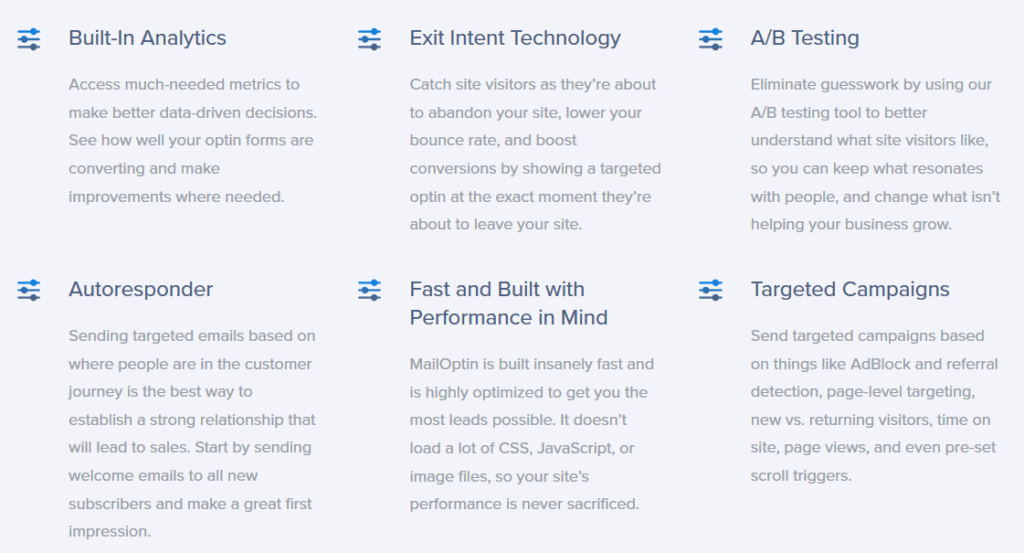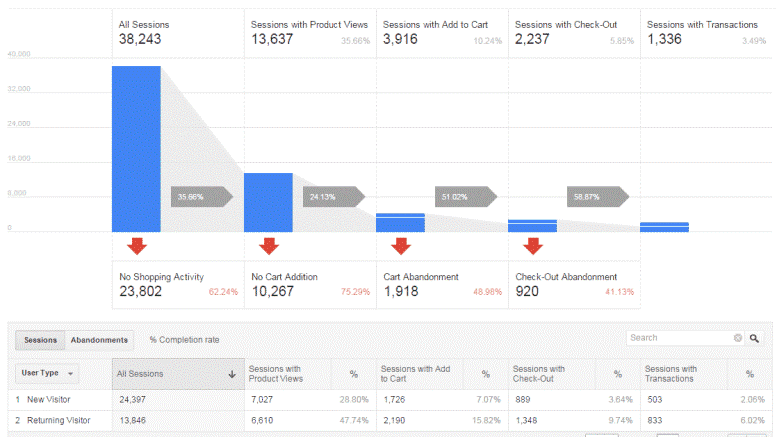How to Get More Out of Your Website’s Existing Traffic
Most people focus on getting more traffic, and often increase their marketing budget to achieve that. But how about first optimising your website to get the most out of the traffic you’re already getting?
Without spending a single penny on another ad campaign, you can improve the conversion rate on your website to get a much better ROI on your current marketing budget.
You just need to get the right tools and make some simple changes to achieve this, and won’t have to spend thousands of dollars on a developer either.
So without further ado, let’s get down to work.
Optimize Your Website’s Conversion Process
Many website owners make the mistake of cluttering their landing pages with too many things, which often confuses visitors and makes it hard for them to get what they came for.
If you have an e-commerce website and show very relevant products on your site’s pages, then your website might be an exception. This is because visitors on an e-commerce website typically tend to buy more when they are shown relevant products, either as a complementary product or as an upsell.
However, for most other types of websites, this usually doesn’t work well. When you clutter your website and ask your visitors to choose from many different things, then they often get confused and decide to check out other options (your competitors!) or just delay their decision (and then never come back to you).
So only ask your visitors to do what your landing page is designed for; don’t try to go too hard on them with your offers. The upsells and pushing other products can come later without hurting your conversions (by using email marketing), which we will get to in a bit.
Make the conversion process very simple and easy to follow. Don’t make the visitors jump through many loops. Make sure the process from the landing page to the conversion page is as less steps as possible, and preferably only a single page unless it really needs to be more than that.

For the homepage, keep things simple and highlight important areas. Avoid having a bunch of text for “SEO purpose.” You can do that in the blog posts instead, and get more out of your traffic through the homepage and other important landing pages.
The visitors should also know what they are supposed to do next. Don’t keep them guessing.
As for the call-to-actions (CTAs), they must be clear, easily visible, and use bright colors. An ideal practice is to avoid using the color you’re using for CTAs for any other elements on the page.
Leverage the Power of Email Marketing
Email marketing is a highly underrated technique for getting a much greater ROI without touching any other marketing channels. It can be surprisingly effective if done right, and you typically spend a fraction of what you would spend to generate the same results using any other marketing channel.
Of course, you do need to have or build an email list before being able to utilize email marketing for your business. Here are a few different ways businesses can build an email list:
- Most businesses collect the email of a user when they make a purchase or convert into a lead
- Using an email opt-in page that pops up when a visitor spends a certain amount of time on your website
- Attracting targeted traffic through relevant, quality blog posts and then converting them into email subscribers (if not customers or leads)
- Offering visitors something for free (like an e-book), for turning into an email subscriber
- Running a giveaway or contest where you ask your followers on social media platforms to sign up as a subscriber
- Set the email opt-in pop-up to show up on landing pages when your visitors spend some time on them without converting into a lead
- Run an ad campaign specifically designed around building an email list (which would be much cheaper as you don’t need to bid on high-value keywords)
There are other ways to gain email subscribers as well, but we have covered the most effective ways that you can use without having to put in a lot of effort.
Once you have built an email list, you have basically built a cash cow that will keep generating you leads and sales in a consistent, recurring manner.
However, you need to nourish it enough as well as keep analyzing your subscribers’ interaction with your emails to figure out a well-optimized strategy that works best for both you and your subscribers.
From the welcome email to tracking the user interaction with your emails to launching targeted campaigns based on different factors and metrics, a lot goes into running successful email marketing campaigns.
If you’re thinking that’s too much work, then you’re wrong. You just need the right email marketing tool like MailOptin, and it will take care of pretty much everything and give you all the information and insight you need to launch and run successful email marketing campaigns as well as effectively build an email list without any technical knowledge at all.

These are just some of the analytical features of MailOptin, and there’s a lot more.
However, you will need to offer value to your email subscribers to utilize email marketing as part of your business’ long-term marketing strategy. Getting too promotional with every other email trying hard to sell the users something is a fast way to kill your email list.
The welcome email – besides welcoming the users and giving a quick introduction about your business – should offer them some value in the form of a free useful resource or blog posts that you think the users will benefit from. Never talk in detail about a product or offer discounts to purchase something in your welcome email, preferably your first few emails.
The majority of your emails should be focused around offering something of value to your subscribers, with some of them being carefully crafted to sell them your product. It might feel tempting to get quick sales right off the bat, but you would be astonished how effective a more restricted, value-focused approach can be in the long term.
Your subscribers would feel much more valued that way, and after all the value you feed them without asking for anything in return, they will be much more likely to convert not just into another customer, but a loyal customer that also spreads the word around about your product or service.
Use Plugins to Understand Your Visitors Better
This might sound obvious, but a surprisingly large number of business owners overlook this aspect of their website. Until you understand your user’s behavior, needs and preferences, you will never be able to get the most out of the traffic you get.
But if you’re using WordPress, then you’re in luck as there are tens of plugins that will help you do this more easily than you can imagine. Let us take a look at some of the best ones below.
Heatmap
A good Heatmap plugin like this one can go a long way in helping you find out how your users interact with your content and landing pages. Here’s how a “heatmap” looks like:

As you can see, it tells you which areas have got the most clicks, and which areas of your landing page have been getting fewer clicks. This works by tracking the mouse activity of users that land on your website.
Based on this analysis, you can optimize the areas not performing as well, and put more focus on the ones that are getting the most results for you.
Elementor
Landing pages are the bread and butter of businesses that are designed to capture leads or set up to sell a particular product or service.
If you neither have the budget to hire a professional to design each of your landing pages nor the technical expertise to do it yourself, then a plugin like Elementor can come in handy.
It comes with tens of predesigned widgets and hundreds of predesigned templates to help you set up professional landing pages that convert well without having to spend thousands of dollars or waste a huge amount of time messing around with any code.

This plugin supports drag-and-drop functionality as well, and allows you to customize pretty much every part of your landing page the way you want, but again, without having to even touch the code.
There’s a free version available as well, but if you’re going to run big ad campaigns for your landing pages, then it makes sense to invest in the pro version.
Google Analytics
While Google Analytics is not exactly a plugin, it can either be installed using third-party plugins or by adding a simple HTML code to your site.
While many business owners already use Google Analytics, they fail to extract all the useful information it has to offer. This information can easily be used to make important changes to your website that would help boost the conversion rate and offer a better user experience.

The above image is for the “goal tracking” feature available in your Google Analytics account. You can set up goals in your account for Google to track them, and get useful insight based on how the users on your site meet those goals.
This would help you optimize the conversion process and find loopholes that may be leading to a lot of lost conversions or leads.
There are tens of other useful metrics, like the time on page and the information about the diversity of your traffic. Based on this information, you can figure out if you have some pages on your site that your users don’t like to spend much time on, or if users are having issues exploring your website on a mobile device.
Once you figure out the issues or loopholes, then it’s just a matter of finding the solution and fixing them (more often than not they aren’t too difficult or expensive to fix) to improve your conversion rate significantly and getting more out of your existing traffic.
Summing It Up
While there’s nothing wrong with spending more on marketing campaigns if you’re being able to do so with a positive ROI, but it would be even better if you can get the best of both worlds by optimizing your site to get the most out of your existing traffic and focusing on increasing targeted traffic to your site.
Further, a well-optimized conversion process means that your marketing campaigns would return a much better ROI, making it easier to scale your campaigns and test new ones.
